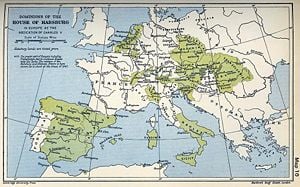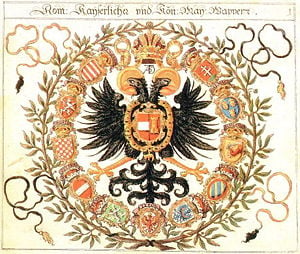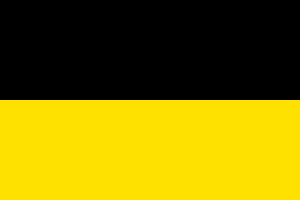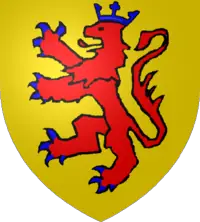Habsburg
Habsburg (in English-speaking countries sometimes spelled Hapsburg, but never so in official use) was an important ruling house of Europe and is most well known to be the ruling House of Austria (and the Austrian Empire) for over six centuries. Through marriage, the family ruled approximately half of Europe. They were Holy Roman Emperors and one of the most powerful families in Europe.
Vienna, the elegant, artistic, and intellectually creative capital of the Habsburg was twice besieged by the Turks (1529 and 1683). On the latter occasion, the Emperor fled from the city. With custody of Bosnia and Herzegovina from 1878 following the Berlin Conference, the Habsburgs represented for many a buffer-zone between East and West; the Muslim and Christian worlds.
Loss of the Austro-Prussian War of 1866 resulted in the Austria-Hungarian Empire losing to its rival, Prussia, in leading German re-unification. Some suggest that had Austria won this contest, German history might have developed along less militaristic lines. Austria-Hungary was more pluralist and towards the end of its existence had embarked on a democratization program. It was the Assassination of Archduke Franz Ferdinand, heir to the Austrian-Hungarian throne, that sparked off the events that led to World War I and to the demise of the Habsburg monarchy.
History
From counts to Roman Emperors
The name is derived from the Swiss Habichtsburg (Hawk Castle), the family seat in the eleventh, twelfth, and thirteenth centuries at Habsburg, Switzerland in the former duchy of Swabia in present-day Switzerland. (Switzerland did not exist in its present form, and the Swiss lands were part of the mainly-Germanic Holy Roman Empire). From southwestern Germany (mainly Alsace, Breisgau, Aargau and Thurgau) the family extended its influence and holdings to the southeastern reaches of the Holy Roman Empire, roughly today's Austria (1278 - 1382).
In 1440, Frederick III was chosen by the Electoral College to succeed Albert II as the king. After several Habsburg kings had attempted to gain the imperial throne over the years, success finally arrived on 19 March 1452, when Pope Nicholas V crowned Frederick III as the Holy Roman Emperor in a grand ceremony held in Rome. After Frederick III's coronation, the Habsburgs were able to hold the imperial throne almost continuously for centuries, (1273 - 1291, 1298 - 1308, 1438 - 1740, and 1745 - 1806).
After the marriage of Maximilian I with Mary of Burgundy, heiress of Burgundy (the Low Countries) and the marriage of his son Philip I of Castile (known as Philip the Handsome) with Joanna of Castile, heiress of Spain and its newly-founded empire, Charles V, Holy Roman Emperor inherited Spain, Southern Italy, Austria, and the Low Countries. In 1580 his son Philip II inherited Portugal and its colonies, thus ruling over an empire where "the sun does not set."
Under Maximilian II, the Habsburgs first acquired the land upon which would later be erected the Schönbrunn Palace: the Habsburgs' summer palace in Vienna and one of the most enduring symbols of the dynasty.
Division of the House: Austrian and Spanish Habsburgs

After the April 21, 1521 assignment of the Austrian lands to Ferdinand I, Holy Roman Emperor from his brother Emperor Charles V, Holy Roman Emperor (also King Charles I of Spain) (1516 - 1556), the dynasty split into one Austrian and one Spanish branch. The Austrian Habsburgs (after 1556) held the title of Holy Roman Emperor, as well as the Habsburg Hereditary Lands and the Kingdoms of Bohemia and Hungary, while the Spanish Habsburgs ruled over the Spanish kingdoms, the Netherlands, the Habsburgs' Italian possessions, and, for a time, Portugal. Hungary, nominally under Habsburg kingship from 1526 but mostly under Ottoman Turkish occupation for 150 years, was reconquered in 1683 - 1699.
The Spanish Habsburgs died out in 1700 (prompting the War of the Spanish Succession), as did the Austrian Habsburgs in 1740 (prompting the War of the Austrian Succession). However, the heiress of the last Austrian Habsburg (Maria Theresa) had married Francis I, Holy Roman Emperor, Duke of Lorraine, (both of them were great-grandchildren of Habsburg Emperor Ferdinand III, but from different empresses) and their descendants carried on the Habsburg tradition from Vienna under the dynastic name Habsburg-Lorraine. It is often speculated that extensive intra-family marriages within both lines contributed to their extinctions, but there were few such marriages in the Austrian line. Smallpox killing young heirs was a greater cause.
House of Habsburg-Lorraine: the Austrian Empire
On August 6, 1806 the Holy Roman Empire was dissolved under the French Emperor Napoleon Bonaparte's reorganization of Germany. However, in anticipation of the loss of his title of Holy Roman Emperor, Francis II declared himself hereditary Emperor of Austria (as Francis I, thereof) on August 11, 1804, three months after Napoleon had declared himself Emperor of France on May 18, 1804.
Emperor Francis II of Austria used the official great title: "We, Francis the First, by the grace of God Emperor of Austria; King of Jerusalem, Hungary, Bohemia, Dalmatia, Croatia, Slavonia, Galicia (Central Europe), and Lodomeria; Archduke of Austria; Duke of Lorraine, Salzburg, WĂŒrzburg, Franconia, Styria, Carinthia, and Carniola; Grand Duke of KrakĂłw; Grand Prince of Transylvania; Margrave of Moravia; Duke of Sandomir, Masovia, Lublin, Upper and Lower Silesia, Auschwitz and Zator, Teschen, and Friuli-Venezia Giulia; Prince of Berchtesgaden and Mergentheim; Princely Count of Habsburg, Gorizia, and Gradisca and of the Tyrol; and Margrave of Upper and Lower Lusatia and Istria]."
In 1867 effective autonomy was given to Hungary under the terms of the Ausgleich or "compromise" until the Habsburgs' deposition from both Austria and Hungary in 1918 following defeat in World War I.
The current head of the Habsburg family is Karl von Habsburg, eldest son of Otto von Habsburg.
Main Line
Before Rudolph I of Germany rose to become Holy Roman Emperor, the Habsburgs were Counts in what is today southwestern Germany and Switzerland.
Ancestors
- Guntram, Count of Habsburg (Guntram the Rich) (ca. 930 - 985 / 990) Father of:
- Lanzelin, Count of Habsburg (d. 991). Besides Radbot, he had sons named Rudolph I, Werner I, Bishop of Strasbourg, and Landolf.
Counts of Habsburg
- Radbot built the Habsburg castle (ca. 985 - 1035.
- Werner I, Count of Habsburg (1025 / 1030 - 1096). Besides Otto II, there was another son, Albert II, who was reeve of Muri from 1111 - 1141 after the death of Otto II.
- Otto II of Habsburg; first to name himself as "of Habsburg" (d. 1111) Father of:
- Werner II of Habsburg (c. 1135 â d. 1167) Father of:
- Albrecht III of Habsburg (the Rich) (d. 1199). Under him, the Habsburg territories expanded to cover most of what is today the German-speaking part of Switzerland. Father of:
- Rudolph II of Habsburg (d. 1232) Father of:
- Albrecht IV of Habsburg, (d. 1239 / 1240); father of Rudolph IV of Habsburg, who would later become king Rudolph I of Germany. Between Albrecht IV and his brother Rudolph III, the Habsburg properties were split, with Albrecht keeping the Aargau and the western parts, the eastern parts going to Rudolph III.
Kings of Germany
- Rudolph I was king of Germany (then an elective position, as its successive post, the Holy Roman Emperor, would be) from 1273 - 1291.
Dukes of Austria
In the late Middle Ages, when the Habsburgs expanded their territories in the east, they often ruled as dukes of the Duchy of Austria which covered only what is today Lower Austria and the eastern part of Upper Austria. The Habsburg possessions also included Styria, and then expanded west to include Carinthia and Carniola in 1335 and Tyrol in 1363. Their original scattered possessions in the southern Alsace, south-western Germany and Vorarlberg were collectively known as Further Austria. The Habsburg dukes gradually lost their homelands south of the Rhine and Lake Constance to the expanding Old Swiss Confederacy. Unless mentioned explicitly, the dukes of Austria also ruled over Further Austria until 1379, after that year, Further Austria was ruled by the Princely Count of Tyrol. Names in italics designate dukes who never actually ruled.
- Rudolph II, son of Rudolph I, duke of Austria and Styria together with his brother 1282 - 1283, was dispossessed by his brother, who was eventually murdered by one of Rudolph's sons.
- Albert I (Albrecht I), son of Rudolph I and brother of the above, duke from 1282 - 1308; was Holy Roman Emperor from 1298 - 1308.
- Rudolph III, oldest son of Albert I, designated duke of Austria and Styria 1298 - 1307
- Frederick "the Handsome" (Friedrich der Schöne), brother of Rudolph III. Duke of Austria and Styria (with his brother Leopold I) from 1308 - 1330; officially co-regent of emperor Louis IV since 1325, but never ruled.
- Leopold I, brother of the above, duke of Austria and Styria from 1308 - 1326.
- Albert II (Albrecht II), brother of the above, duke of Vorderösterreich from 1326 - 1358, duke of Austria and Styria 1330 - 1358, duke of Carinthia after 1335.
- Otto "the Jolly" ("der Fröhliche"), brother of the above, duke of Austria and Styria 1330 - 1339 (together with his brother), duke of Carinthia after 1335.
- Rudolph IV "the Founder" ("der Stifter"), oldest son of Albert II. Duke of Austria and Styria 1358 - 1365, Duke of Tyrol after 1363.
After the death of Rudolph IV, his brothers Albert III and Leopold III ruled the Habsburg possessions together from 1365 until 1379, when they split the territories in the Treaty of Neuberg, Albert keeping the Duchy of Austria and Leopold ruling over Styria, Carinthia]], Carniola, the Windish March, Tyrol, and Further Austria.
Albertine line: Dukes of Austria
- Albert III (Albrecht III), duke of Austria until 1395, from 1386 (after the death of Leopold) until 1395 also ruled over the latter's possessions.
- Albert IV (Albrecht IV), duke of Austria 1395 - 1404, in conflict with Leopold IV.
- Albert V (Albrecht V), duke of Austria 1404 - 1439, Holy Roman Emperor from 1438 - 1439 as Albert II.
- Ladislaus Posthumus of Bohemia and Hungary, son of the above, duke of Austria 1440 - 1457.
Leopoldine line: Dukes of Styria, Carinthia, Tyrol
- Leopold III of Austria, duke of Styria, Carinthia, Tyrol, and Further Austria until 1386, when he was killed in the Battle of Sempach.
- William (Wilhelm), son of the above, 1386 - 1406 duke in Inner Austria (Carinthia, Styria)
- Leopold IV, son of Leopold III, 1391 regent of Further Austria, 1395 - 1402 duke of Tyrol, after 1404 also duke of Austria, 1406 - 1411 duke of Inner Austria
Leopoldine-Inner Austrian sub-line
- Ernest "the Iron" ("der Eiserne"), 1406 - 1424 duke of Inner Austria, until 1411 together and competing with his brother Leopold IV.
- Frederick V (Friedrich), son of Ernst, became Holy Roman Emperor Frederick III in 1440. He was duke of Inner Austria from 1424 on. Guardian of Sigismund of Austria (1439 - 1446) and of Ladislaus Posthumus of Bohemia and Hungary (1440 - 1452).
- Albert VI (Albrecht VI), brother of the above, 1446 - 1463 regent of Further Austria, duke of Austria 1458 - 1463
Leopoldine-Tyrol sub-line
- Frederick IV (Friedrich), brother of Ernst, 1402 - 1439 duke of Tyrol and Further Austria
- Sigismund, also spelled "Siegmund" or "Sigmund," 1439 - 1446 under the tutelage of the Frederick V above, then duke of Tyrol, and after the death of Albrecht VI in 1463 also duke of Further Austria.
Reuniting of Habsburg possessions
Sigismund had no children and adopted Maximilian I, Holy Roman Emperor, son of duke Frederick V (emperor Frederick III). Under Maximilian, the possessions of the Habsburgs would be united again under one ruler, after he had re-conquered the Duchy of Austria after the death of Matthias Corvinus, who resided in Vienna and styled himself duke of Austria from 1485 - 1490.
German Kings and Holy Roman Emperors previous to the reunion of the Habsburg possessions
- Rudolph I, emperor 1273 - 1291 (never crowned)
- Albert I, Holy Roman Emperor, emperor 1298 - 1308 (never crowned)
- Albert II, emperor 1438 - 1439 (never crowned)
- Frederick III, Holy Roman Emperor, emperor 1440 - 1493
Kings of Hungary previous to the reunion of the Habsburg possessions
- Albert, king of Hungary 1437 - 1439
- Ladislaus Posthumus of Bohemia and Hungary, king of Hungary 1444 - 1457
Main Line: Holy Roman Emperors, Archdukes of Austria
- Maximilian I, emperor 1493 - 1519
- Charles V, emperor 1519 - 1556
Habsburg Spain|Spanish Habsburgs: Kings of Spain, Kings of Portugal (1580-1640)
- Philip I of Castile, second son of Maximilian I, Holy Roman Emperor, founded the Spanish Habsburgs in 1506 by marrying Joanna the Mad, daughter of Ferdinand and Isabella. Philip promptly died, leaving the thrones of Castile and Aragon to be inherited and united into the nation of Spain by his son:
- Charles I 1516-1556, converdivided the House into Austrian and Spanish lines
- Philip II of Spain 1556-1598, also Philip I of Portugal 1580-1598
- Philip III, also Philip III of Spain (Philip II of Portugal) 1598-1621
- Philip IV 1621-1665, also Philip III of Portugal 1621-1640
- Charles II 1665-1700
The War of the Spanish Succession took place after the extinction of the Spanish Habsburg line, to determine the inheritance of Charles II.
Austrian Habsburgs: Holy Roman Emperors, Archdukes of Austria
- Ferdinand I, emperor 1556 - 1564
- Maximilian II, emperor 1564 - 1576
- Rudolph II, emperor 1576 - 1612
- Matthias, emperor 1612 - 1619
- Ferdinand II, emperor 1619 - 1637
- Ferdinand III, emperor 1637 - 1657
- Leopold I, emperor 1658 - 1705
- Josef I, emperor 1705 - 1711
- Charles VI, emperor 1711 - 1740
Maria Theresa of Austria, Habsburg heiress and wife of emperor Francis I Stephen]], reigned as Archduchess of Austria and Queen of Kingdom of Hungary and Bohemia 1740 - 1780.
House of Habsburg-Lorraine, main line: Holy Roman Emperors, Archdukes of Austria
- Francis I Stephen, emperor 1745 - 1765
- Joseph II, emperor 1765 - 1790
- Leopold II, emperor 1790 - 1792
- Francis II, emperor 1792 - 1806
Queen Maria Christina of Austria of Spain-great-granddaugther of Leopold II, Holy Roman Emperor above. Wife of Alfonso XII of Spain and mother of Alfonso XIII.
The House of Habsburg-Lorraine retained Austria and attached possessions after the dissolution of the Holy Roman Empire; see below.
House of Habsburg-Lorraine: Grand dukes of Tuscany
- Francis Stephen 1737-1765 (later Francis I, Holy Roman Emperor)
Francis Stephen assigned the grand duchy of Tuscany to his second son Peter Leopold, who in turn assigned it to his second son upon his accession as Holy Roman Emperor. Tuscany remained the domain of this cadet branch of the family until Italian unification.
- Peter Leopold 1765-1790 (later Leopold II, Holy Roman Emperor)
- Ferdinand III 1790-1800, 1814-1824
- Leopold II 1824-1849, 1849-1859
- Ferdinand IV 1859-1860
House of Habsburg-Lorraine: Tuscany line, post-monarchy
- Ferdinand IV 1860-1908
- Peter Ferdinand 1908-1948
- Gottfried 1948-1984
- Leopold Franz 1948-1993
- Sigismund 1993-Present
House of Habsburg-Lorraine: Dukes of Modena
The duchy of Modena was assigned to a minor branch of the family by the Congress of Vienna. It was lost to Italian unification.
- Francis IV 1814-1831, 1831-1846
- Francis V 1846-1848, 1849-1859
House of Habsburg-Lorraine: Duchess of Parma
The duchy of Parma was likewise assigned to a Habsburg, but did not stay in the House long before succumbing to Italian unification.
- Marie Louise of Austria 1814-1847
House of Habsburg-Lorraine: Emperor of Mexico
Maximilian, an adventurous younger son, was invited as part of Napoleon III's manipulations to take the throne of Mexico and rule with his wife Carlota. The adventure did not end well. Maximilian was shot in "Cerro de las Campanas" in 1867.
- Maximilian I 1864-1867
House of Habsburg-Lorraine, main line: Emperors of Austria
- Franz I, emperor of Austria 1804 - 1835: was Francis II, Holy Roman Emperor;
- Ferdinand I, emperor of Austria 1835 - 1848
- Franz Joseph, emperor of Austria 1848 - 1916, sometimes referred to in English as "Francis Joseph"
- Karl, emperor of Austria 1916 - 1918, sometimes referred to in English as "Charles." He died in exile in 1922 after Austria's defeat in World War I.
House of Habsburg-Lorraine, main line: Heads of the House of Habsburg (post-monarchy)
Charles I was expelled from his domains after World War I and the empire was abolished. The Habsburg Law of 1918 stated that Charles' descendants could only return to Austria if they renounced their royal claims and accepted the status of private citizens. In a declaration dated 31 May 1961, Otto renounced all claims to the Austrian throne and proclaimed himself "a loyal citizen of the republic," a move that he made only after much hesitation and certainly "for purely practical reasons." In 1963 the Austrian administrative court found that Otto's statement was sufficient to meet this requirement. In June 1966, Otto was issued an Austrian passport and was finally able to visit his home country again in October 1966 for the first time in 48 years.
- Charles I (1918-1922)
- Otto von Habsburg (1922-2011)
- Zita of Bourbon-Parma, guardian, (1922-1930)
- Karl von Habsburg, referred to in Austria as Karl Habsburg-Lothringen and in Hungary as Habsburg KĂĄroly, (2011-present)
Habsburgs as Kings of Hungary
The kingship of Kingdom of Hungary Hungary remained in the Habsburg family for centuries; but as the kingship was not strictly inherited (Hungary was an elective monarchy till 1687) and was sometimes used as a training ground for young Habsburgs, the dates of rule do not always match those of the primary Habsburg possessions. Therefore, the kings of Hungary are listed separately.
Albertine line: Kings of Hungary
- Albert II, Holy Roman Emperor, king of Hungary 1437 - 1439
- Ladislaus Posthumus of Bohemia and Hungary, king of Hungary 1444 - 1457
Austrian Habsburgs: Kings of Hungary
- Ferdinand I, king of Hungary 1526 - 1564
- Maximilian I, king of Hungary 1563 - 1576
- Rudolf I, king of Hungary 1572 - 1608
- Matthias, king of Hungary 1608 - 1619
- Ferdinand II, king of Hungary 1618 - 1637
- Ferdinand III, king of Hungary 1625 - 1657
- Ferdinand IV, king of Hungary 1647 - 1654
- Leopold I, king of Hungary 1655 - 1705
- Joseph I, king of Hungary 1687 - 1711
- Charles III, king of Hungary 1711 - 1740
House of Habsburg-Lorraine, main line: Kings of Hungary
- Maria Theresa, queen of Hungary 1741 - 1780
- Joseph II, king of Hungary 1780 - 1790
- Leopold II, king of Hungary 1790 - 1792
- Francis, king of Hungary 1792 - 1835
- Ferdinand V, king of Hungary 1835 - 1848
- Francis Joseph I, king of Hungary 1848 - 1916
- Charles IV, king of Hungary 1916 - 1918
Habsburgs as Kings of Bohemia
The kingship of Bohemia was for centuries a position elected by its nobles. As a result, it was not an automatically inherited position. The king of Bohemia tended to be a Habsburg, but was not always. Hence, the kings of Bohemia and their ruling dates are listed separately.
Main line: Kings of Bohemia
- Rudolph I, king of Bohemia 1306-1307
Albertine line: kings of Bohemia
- Albert, king of Bohemia 1437 - 1439
- Ladislaus Posthumus of Bohemia and Hungary, king of Bohemia 1444 - 1457
Austrian Habsburgs: kings of Bohemia
- Ferdinand I, king of Bohemia 1526 - 1564
- Maximilian I, king of Bohemia 1563 - 1576
- Rudolph II, king of Bohemia 1572 - 1611
- Matthias, king of Bohemia 1611 - 1618
- Ferdinand II, king of Bohemia 1621 - 1637
- Ferdinand III, king of Bohemia 1625 - 1657
- Ferdinand IV, king of Bohemia 1647 - 1654
- Leopold I, king of Bohemia 1655 - 1705
- Joseph I, king of Bohemia 1687 - 1711
- Charles II, king of Bohemia 1711 - 1740
House of Habsburg-Lorraine, main line: kings of Bohemia
From the accession of Maria Theresa, the kingship of Bohemia became united with the Austrian possessions.
- Maria Theresa, queen of Bohemia 1743 - 1780
- Joseph II, king of Bohemia 1780 - 1790
- Leopold II, king of Bohemia 1790 - 1792
- Francis, king of Bohemia 1792 - 1835
- Ferdinand V, king of Bohemia 1835 - 1848
- Francis Joseph I, king of Bohemia 1848 - 1916
- Charles III, king of Bohemia 1916 - 1918
Habsburgs as Queens Consort of France
From the sixteenth through the eighteenth centuries, the greatest non-Habsburg power in Europe was usually France. As a result, in usually futile attempts to either unite Europe under the Habsburg family or to prevent French enmity, Habsburg daughters were wed to successive kings of France.
Austrian Habsburgs
- Elisabeth of Austria (1554-1592), wife of King Charles IX of France
- Leonor of Austria, Infanta of Spain (1498-1558), wife of King Francis I of France.
Spanish Habsburgs
- Anne of Austria, infanta of Spain, (1601 - 1666), wife of King Louis XIII of France
- Maria Theresa of Spain (1638 - 1683), wife of King Louis XIV of France
Habsburg-Lorraine
- Marie Antoinette (1755 - 1793), wife of King Louis XVI of France
See also
ReferencesISBN links support NWE through referral fees
- Brewer-Ward, Daniel A. The House of Habsburg: A Genealogy of the Descendants of Empress Maria Theresia. Baltimore, MD: Genealogical Pub. Co. Clearfield, 1996. ISBN 0806346442
- Crankshaw, Edward. The Fall of the House of Habsburg. Penguin, 1983. ISBN 978-0140064599
- Evans, Robert J. W. The Making of the Habsburg Monarchy, 1550-1700: An Interpretation. Oxford, UK: Clarendon Press, 1979. ISBN 0198730853
- McGuigan, Dorothy Gies. The Habsburgs. Garden City, NJ: Doubleday, 1966. ASIN B0000CN86H
- Wandruszka, Adam. The House of Habsburg: Six Hundred Years of a European Dynasty. (original 1964) Westport, CT: Greenwood Press, 1975. ISBN 0837179289
External links
All links retrieved June 21, 2024.
- Stephen Herold Habsburg Biographies
- House of Habsburg
- End of a royal dynasty as Otto von Habsburg is laid to rest... with his heart buried in a crypt 85 miles away Daily Mail, July 18, 2011.
Credits
New World Encyclopedia writers and editors rewrote and completed the Wikipedia article in accordance with New World Encyclopedia standards. This article abides by terms of the Creative Commons CC-by-sa 3.0 License (CC-by-sa), which may be used and disseminated with proper attribution. Credit is due under the terms of this license that can reference both the New World Encyclopedia contributors and the selfless volunteer contributors of the Wikimedia Foundation. To cite this article click here for a list of acceptable citing formats.The history of earlier contributions by wikipedians is accessible to researchers here:
The history of this article since it was imported to New World Encyclopedia:
Note: Some restrictions may apply to use of individual images which are separately licensed.


